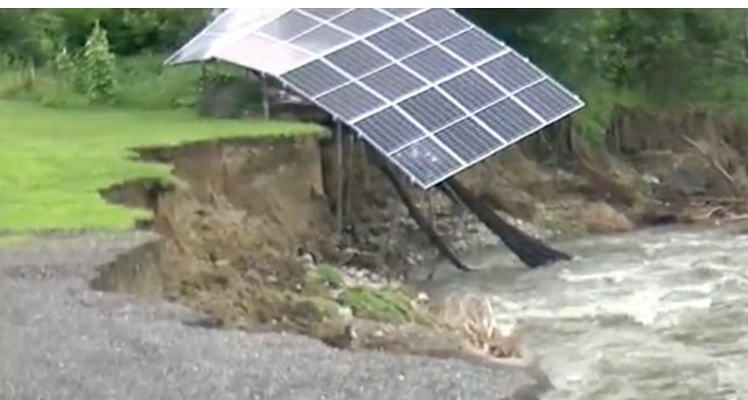A couple of left-wing columnists recently penned articles lamenting the fact that Montpelier keeps flooding every decade or so, yet local and state governments don’t do anything about it and aren’t prepared for it when it happens. A keen observation.
Kevin Ellis, in his piece, quoted a Montpelier restaurateur as saying, “We pay a lot of taxes to the city and the state, and this keeps happening over and over. I cleaned out our basement with a bunch of high school kids. It was totally dangerous. Where was the help from the government?’’
Well, the “help” from the government came in the form of all those electric car charging stations, EV rebates, and subsidies for renewable electricity generation. The Vermont state policy for dealing with changing climate is to lower our carbon footprint so that these kinds of extreme weather events don’t ever happen. We spend around $250 million a year on these programs. You’re saying it’s not working out?
Ellis asks, “Why do we continue to build along a river that floods?”
That I can answer! Because it’s a central part of Vermont’s environmental policy as well as the Global Warming Solutions Act (GWSA), you and all your alarmist pals praised to the high heavens as it was being crafted and passed over the Governor’s veto.
To quote Vermont’s Climate Action Plan (CAP), “For the past 50 years, Governors, state agencies, the General Assembly, non-profit advocacy groups, regional entities, and cities and towns have worked collectively and intentionally to strengthen Vermont’s downtowns and villages and the state’s historic settlement pattern of compact centers surrounded by farms and forest lands (P.223, emphasis added).” And to be clear, the historic pattern for compact settlements in Vermont is to put them in floodplains.
The CAP also states, “Compact settlement, sometimes referred to as ‘smart growth’ [LOL, the irony!], is a key strategy for addressing climate change (P.219).” And, given this key strategy, we should “Support public-private partnerships to fund the design and construction of new infill housing in existing neighborhoods.” Yes, the ones in the floodplains. And “Expand the eligibility of the existing downtown and village center tax credit programs to revitalize neighborhood housing in and around state-designated centers” that are in floodplains.
The reason behind this policy strategy of funneling as many of us citizens (and our stuff) as possible into Mother Nature’s aquatorial kill zones. They think if you’re forced to live in a “compact urban center,” you’ll give up your car and walk or bike to work, the grocery store, etc., lowering your carbon footprint to save the planet – but not your house, which will be destroyed the next time the Winooski overflows its banks.
This is just Vermonters “doing our part” to show the world we know how to combat climate change so others will follow our example. If they are paying attention at all, what must they be thinking now?
The other pundit of note to weigh in on the watery state of affairs in the Capitol City is Dave Gram, who offers up a Simpsons-esque plan to basically move the entirety of Montpelier to higher ground. Though I tease, and all of what he suggests is far beyond the realm of possibility, which he admits himself, Gram’s idea that the old College of Fine Arts property, elevation 664 feet, be re-developed as a shopping or mixed living area has merit if the property is still available. I can totally see converting that quad into a tastefully landscaped shopping/dining area with eight or ten shops, maybe anchored by a relocated Bear Pond Books and Positive π—perhaps a less rapey co-op grocery store option.
This makes a lot more sense than Ellis’ proposal for building some sort of New Orleans or Holland-style system of levies, dykes, and pumps to keep nature at bay. But I applaud both writers for, perhaps unwittingly, coming to the conclusion that practical adaptation to a changing climate makes a whole lot more sense than trying to stop the weather through what is essentially the modern-day practice of making sacrifices to the gods. “Here, Poseidon, I offer you my SUV. Please spare me from your rage.”
But be aware that either of these erstwhile leftists’ proposals will be dead on arrival at the hands of the very environmental activists Gram and Ellis have done so much to support because raising Montpelier up ten feet, moving all or part of it, or protecting it with massive sea walls and pump systems will all require substantial amounts of fossil fuel operated machinery and carbon-intense building materials and practices to accomplish. Can’t do this and achieve the GWSA greenhouse gas reduction goals at the same time! So, sorry, boys.
Moreover, these types of preparations will also require a lot of private and public dollars, which will require a booming economy to generate and an expanding labor force to implement – things states and countries that have adopted extreme CO2 reduction policies like our GWSA do not have—quite the opposite.
Gram concludes his piece, “We recognize — and now must act on this recognition — that we can’t keep doing things the way we have been.” He’s correct. And what we’ve been doing is prioritizing greenhouse gas reduction over adaptation and preparation as a policy for dealing with extreme weather events. So, yes, let’s stop doing this. Today.
Rob Roper is a freelance writer with 20 years of experience in Vermont politics including three years service as chair of the Vermont Republican Party and nine years as President of the Ethan Allen Institute, Vermont’s free market think tank.

